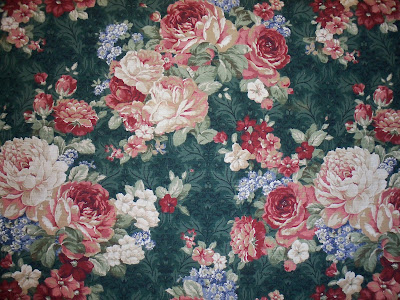Perhaps it is because they are the last soft pinks, yellows, whites and reds we’ll see for several months. Perhaps it is because they are so few and are surrounded by the falling foliage and dried stalks and seed heads of their companion plants. And perhaps it is because their fragrance, intensified by the low sun, mingles with all the musty autumn scents and the bees anxiously try to visit each blossom.
The English produce amazing roses and rose-patterned textiles. Here is David Austin’s ‘Mary Rose’ with Bennison’s Roses (left) and Rosevine (right). Did the rose inspire the fabrics or vice versa? What’s interesting is that, while we associate David Austin Roses and Bennison Fabrics with English culture and design, they are both relatively new ventures in the history of English horticulture and fabric manufacture.
Geoffrey Bennison was born in 1921 and worked from the 1940s on… first as an artist, then an antiques dealer and eventually a decorator. He actually had very few residential clients but his rooms are still famous today for their sumptuousness and luxury. He appreciated craftsmanship, whether ancient or 20th century, at a time when so many decorative items were being mass produced. And he encouraged his customers to invest in truly unique pieces… often oversized, slightly distressed or worn or faded, but always constructed out of exquisite materials… ceramic, marble, leather, lacquer, mirror, and of course beautiful textiles. Bennison Fabrics was established in 1985, after Geoffrey’s death, from his collection of 18th and 19th century French and English fabrics. All Bennison fabrics are silkscreened by hand, usually on linen or silk, and the wallpapers are printed on handmade paper.
Here is Bennison’s Salzburg in an autumnal palette.
And their Roses, again, but in a not-so-traditional lipstick pink with Rosa ‘Cherry Parfait’. ‘Cherry Parfait’ always looks a little garish to me at the peak of summer. But by fall, its blooms seem more mellow. Is it the light? Or is the plant literally fading, becoming more quiet, before winter?
There are other English textile designers who draw regular inspiration from roses. Jane Churchill’s Nerissa could easily have been embroidered from this Portland rose.
And Tricia Guild’s Zephirine, available in fabric and wallpaper from Designers Guild, reminds me of the open, smiling blossoms of Rosa ‘Carefree Wonder’.
All of these fabrics are gorgeous, but they may stretch our budgets beyond comfort. So I visited Second Yard, a local furniture, fabric and home accessories shop, in search of rose-patterned textiles for under $100 a yard and found… a lot! They had bolt after bolt of floral fabrics, including one whole section of roses in bronzes, burnished corals, faded yellows and mustards and muted plums and cerises that really made me think of autumn.
They had another whole room devoted to blues and reds where I found the following bolder fabrics. I’ve always liked these casual, slightly grandmotherly patterns that are literally covered with blowsy blooms. The patterns hide a multitude of sins, and cotton is easy care. Can you tell the first fabric is quilted? Imagine it on a family room sofa or mudroom bench.
What about a slipcovered headboard with lots of white linens in your guest bedroom?
Take a cue from nature… notice how all the green foliage highlights the blossoms’ delicate pink? Use this traditional dark fabric to line linen drapery panels in pale, pale blush.
All very pretty, right? But not quite the sophistication of the English fabrics. So I dug through the cut yardage books and hanging samples at Second Yard to find… the appropriately named Faded Glory by P/Kaufmann.
Mecox Bay by Nautica Robert Allen is a herringbone weave with sepia tones. I’ve actually used this fabric for throw pillows in a friend’s living room… a single, male friend, in fact. We were looking for something to soften his very conservative, very dark upholstery and this worked perfectly. It would look beautiful in a bedroom or home office as well.
Both Kravet and Portfolio Textiles still handle some of the older Laura Ashley patterns, including this lovely rose floral called Santorini (Pattern LA1337). I especially like it in salmon (Color 1619), but it also comes in icier tones.
This amazing wallpaper is Josephine Floral from Schumacher’s Silk Road Sojourn collection. The overscaled, almost Art Deco motif really captures the architecture of a rose blossom.
Duralee’s Laurelton Collection (Book 2639) includes many beautiful floral designs. I especially like this one (41994-137), because it reminds me of Rosa ‘Johann Strauss’ which starts as a soft apricot and fades to almost white.
And finally, I found the charming Confection by Richloom Fabrics Group. They call this color geranium but it’s really more of a paprika. I hope I’ve inspired you to plant roses around your garden and house! And I hope you take a moment to enjoy the roses that are in bloom right now.
Some of these roses were photographed in my own garden. Many more were taken at Lewis Ginter Botanical Garden in Richmond, Virginia where they grow over 1,800 roses. Lewis Ginter is hosting a Rose Fest this weekend, October 1 and 2, from noon until 3 pm, both days. It’s really the last explosion of rose blooms… at least until next year! Plus they are offering special demonstrations, rose and rosehip tea tastings, and tango lessons on Saturday and opera performances on Sunday.
Lewis Ginter Botanical Garden is located at 1800 Lakeside Avenue, just north of Richmond, and is easily accessible from Interstates 64 and 95 and downtown Richmond. The Garden is open 9-5 daily, except for a few holidays. There is an admission fee. Hope to see you there!

















































